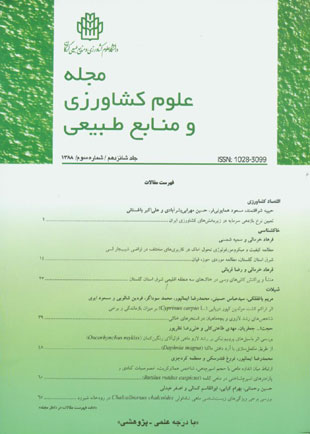Investigation of the quality and micromorphology of soil evolution in different landuses of a loess hillslope of Golestan province, a case study in Ghapan region
Author(s):
Abstract:
Rapid growth of population, and the consequent in creasing request for food, has resulted in the intensive cultivation and finally deterioration of natural covering of land surface, especially in forests. Soil quality is affected adversely as well. In order to study the effects of different land vegetation covers on soil quality attributes, a loess hillslope was selected in eastern Golestan province, Ghapan watershed. Four profiles in four land uses including Quercuse natural forest; Pinus plantation; Cupressus plantation and a cultivated land, were dug and studied. Samples from different horizons were collected for physico-chemical and microscopic analyses. Results showed that mean weight diameter of aggregates (MWD) was significantly different in the studied landuses and varied between 1.6 mm in Quercuse natural forest and 0.31 mm in cultivated land use. The lowest CEC, microbial respiration rate and organic carbon were 28.4 cmol kg-1, 177 μgCO2/g day and 1.32% in cultivated land use. Organic matter content in the forest area was considerably higher than that of the cultivated land use. Soil profile development studies revealed that forest soils were highly developed. Quercuse natural forest soils were classified as Calcic Haploxeralfs with a well developed argillic horizon unlike cultivated soils which showed the minimum development and classified as Typic Xerorthents. The soils of plantation had mollic epipedon and were classified as Typic Calcixerolls with moderate development. Micromorphological properties of soils can help consider changes in pedogenic processes occurring under different land covers. Formation of argillic horizon with speckled and some crystallitic b-fabric in the natural forest indicates to the high landscape stability. In contrast, crystallitic b-fabric of other land uses showed the absence of enough leaching of carbonate for the subsequent migration of clay particles. Intense erosion of the surface horizons of cultivated land use has resulted in the outcropping of the subsurface carbonate rich horizon preventing soil development.
Language:
Persian
Published:
Journal of Agricultural Sciences and Natural Resources, Volume:16 Issue: 3, 2010
Page:
14
magiran.com/p723832
دانلود و مطالعه متن این مقاله با یکی از روشهای زیر امکان پذیر است:
اشتراک شخصی
با عضویت و پرداخت آنلاین حق اشتراک یکساله به مبلغ 1,390,000ريال میتوانید 70 عنوان مطلب دانلود کنید!
اشتراک سازمانی
به کتابخانه دانشگاه یا محل کار خود پیشنهاد کنید تا اشتراک سازمانی این پایگاه را برای دسترسی نامحدود همه کاربران به متن مطالب تهیه نمایند!
توجه!
- حق عضویت دریافتی صرف حمایت از نشریات عضو و نگهداری، تکمیل و توسعه مگیران میشود.
- پرداخت حق اشتراک و دانلود مقالات اجازه بازنشر آن در سایر رسانههای چاپی و دیجیتال را به کاربر نمیدهد.
In order to view content subscription is required
Personal subscription
Subscribe magiran.com for 70 € euros via PayPal and download 70 articles during a year.
Organization subscription
Please contact us to subscribe your university or library for unlimited access!


